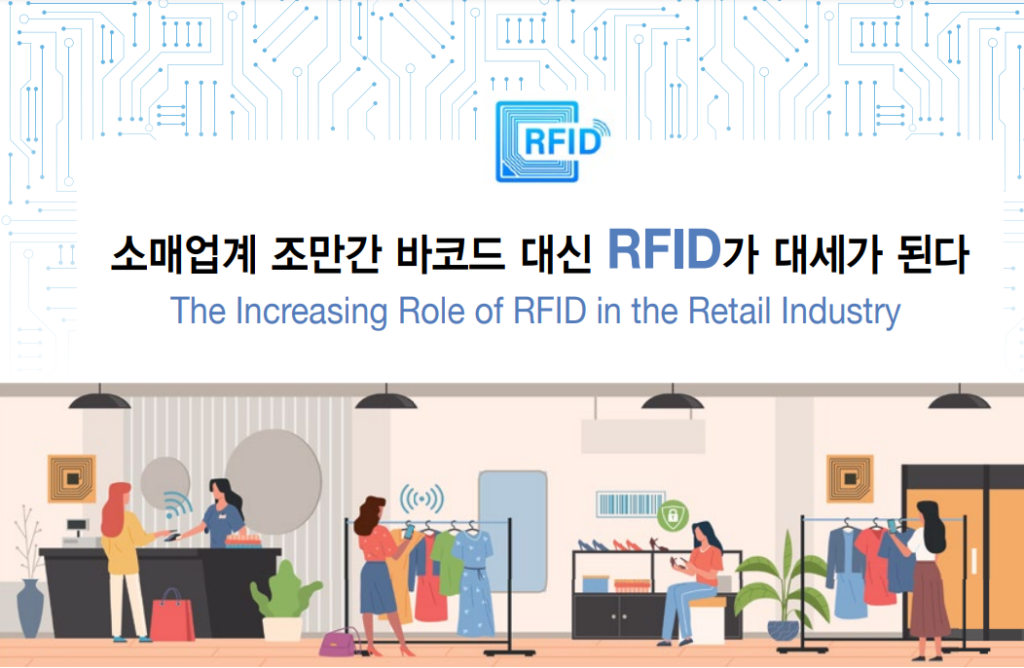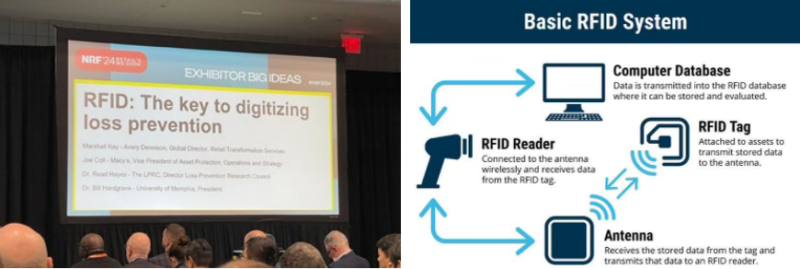
최근 몇 년동안 소매업계 운영해서 크게 주목을 받은 기술 중 하나는 무선 주파수 식별(RFID, Radio Frequency Idenfication)이다. 상품에 고유 코드가 기록된 전자태그를 부착시켜, 무선신호를 이용하여, 해당 상품의 정보를 인식.식별하는 기술로써 ‘무선식별’, ‘전자태그’, ‘스마트태그’, ‘전자라벨’ 등으로 불리기도 한다. 쉽게 말해, 바코드와 유사한 기능을 하는 것이다. RFID가 바코드 시스템과 다른 점은 빛을 이용해 판독하는 대신 전파를 이용한다는 것이다. 따라서 바코드 판독기처럼 짧은 거리에서만 작동하지 않고 먼 거리에서도 태그를 읽을 수 있으며, 심지어 사이에 있는 물체를 통과해서 정보를 수신할 수도 있다. 톨게이트 자동통과시 통과료도 RFID 기술을 이용한 것이다.
RFID는 소매업체가 재고를 관리하는 방식에 혁명을 일으키고 있으며, 소매 부문에서 점점 더 중요한 역할을 하고 있다. 이번 NRF 2024 쇼에서도 RFID 기술이 탑재된 제품을 갖고 참여한 전시업체들이 다수였고, 점점 더 발전되고 있음을 알 수 있었다. RFID 이점을 살펴본다.
One of the technologies that has garnered significant attention in the retail industry over the past few years is Radio Frequency Identification (RFID). This technology involves attaching an electronic tag with a unique code to a product and using wireless signals to recognize and identify the information of the respective product. It is also known by various terms such as ‘wireless identification,’ ‘electronic tag,’ ‘smart tag,’ and ‘electronic label.’ In simple terms, it functions similarly to a barcode. The difference between RFID and barcode systems lies in the fact that RFID utilizes radio waves instead of light for reading. Therefore, RFID can operate not only at short distances like barcode scanners but also read tags from a considerable distance and even through objects.
RFID is revolutionizing the way retail businesses manage inventory and is playing an increasingly important role in the retail sector. At the NRF 2024 show, numerous exhibitors showcased products incorporating RFID technology, indicating its ongoing advancements. Let’s explore the advantages of RFID.
1. 향상된 재고 가시성:
소매업에서 RFID의 주요 장점 중 하나는 재고에 대한 실시간 가시성(Visibility)을 제공하는 능력이다. 가시성 스캔이 필요한 기존 바코드 시스템과 달리 RFID 태그는 원격으로 동시에 읽을 수 있으므로 소매업체가 좀 더 정확하고 효율적으로 재고를 추적할 수 있다. 이러한 향상된 가시성은 소매업체가 재고 불일치를 즉시 식별하고 해결하여 품절 상황을 최소화 하고 과잉 재고를 방지하는 데 도움이 된다.
예를 들어, RFID 기술을 구현하는 의류 가발업체는 각 가발 품목이 매장에 도착하는 순간부터 판매 시점까지의 이동을 쉽게 추적할 수 있다. 이를 통해 인기 품목을 파악하고 그에 따라 재고를 보충할 수 있어 고객이 항상 원하는 제품을 찾을 수 있다.
1. Enhanced Inventory Visibility:
One of the key advantages of RFID in the retail industry is its ability to provide real-time visibility into inventory. Unlike traditional barcode systems that require visibility scans, RFID tags can be read remotely simultaneously, allowing retailers to track inventory more accurately and efficiently. This improved visibility enables retail businesses to identify and address inventory discrepancies immediately, minimizing out-of-stock situations, and preventing excess inventory
For example, a wig manufacturing company implementing RFID technology can easily track the movement of each wig item from the moment it arrives in the store to the point of sale. This allows them to identify popular items and replenish inventory accordingly, ensuring that customers always find the products they desire.
2. 간소화된 재고 관리:
RFID 기술은 재고 관리 프로세스를 간소화하여 효율성을 높이고 인적 오류를 줄인다. RFID 태그를 사용하면 소매업체는 재고 계산, 수령, 보충 등의 작업을 자동화하여 귀중한 시간과 자원을 절약할 수 있다. 식품점의 경우 부패하기 쉬운 품목을 관리하기 위해 RFID를 활용하고 있다. 각 제품에 RFID 태그를 부착함으로써 매장에서는 만료일을 모니터링하고 품목이 유통기한에 가까워지면 자동으로 경고를 실행할 수 있다. 이러한 사전 예방적 접근 방식을 통해 만료된 제품을 즉시 제거하여 낭비를 줄이고 고객 만족도를 높일 수 있다.
2. Streamlined Inventory Management:
RFID technology simplifies the inventory management process, increasing efficiency and reducing human errors. By using RFID tags, retail businesses can automate tasks such as inventory counting, receiving, and replenishment, saving valuable time and resources.
In the case of grocery stores, RFID is utilized to manage perishable items. Attaching RFID tags to each product allows the store to monitor expiration dates and automatically trigger alerts as items approach their expiration dates. This proactive approach enables the immediate removal of expired products, reducing waste and enhancing customer satisfaction.
3. 향상된 고객 경험:
RFID 기술은 전반적인 고객 경험을 크게 향상시킬 수 있다. 재고를 정확하게 추적함으로써 소매업체는 제품 가용성을 높이고 대기 시간을 줄이며 결제 프로세스의 효율성을 높일 수 있다. 결과적으로 고객이 더 행복해져서 매장을 다시 방문하고 다른 사람에게 추천할 가능성이 높아진다.
백화점의 피팅룸에서는 RFID 기술을 사용한다. 각 의류에 RFID 태그를 장착함으로써 고객은 피팅룸을 떠나지 않고도 다양한 사이즈나 색상을 쉽게 요청할 수 있다. 휴대용 RFID 리더기를 갖춘 매장 직원은 요청한 품목을 신속하게 찾아 원활하고 개인화된 쇼핑 경험을 고객들에게 제공할 수 있다. 예를 들면 가발제품의 경우 재고 창고에서 상품을 일일이 스캔하지 않아도 한 두 방향으로 RFID 머신을 쏘기만하면 위치와 재고숫자를 알아낼 수 있다.
3. Improved Customer Experience:
RFID technology can significantly enhance the overall customer experience. By accurately tracking inventory, retail businesses can increase product availability, reduce wait times, and improve the efficiency of the payment process. As a result, customers are more likely to be satisfied, revisit the store, and recommend it to others.
In department store fitting rooms, RFID technology is employed. By attaching RFID tags to each garment, customers can easily request various sizes or colors without leaving the fitting room. Store employees equipped with portable RFID readers can quickly locate the requested items, providing customers with a seamless and personalized shopping experience. For example, in the case of wig products, using RFID machines in the inventory warehouse allows for easy identification of the location and stock without the need to individually scan each item.
4. 도난 방지 조치:
RFID 태그는 소매점의 도난을 방지하고 축소를 줄이는 효과적인 수단으로도 사용될 수 있다. 출구에 RFID가 활성화된 보안 게이트를 설치하면 소매업체는 지불한 품목만 매장에서 나가는 것을 확인할 수 있다. 활성 RFID 태그가 있는 품목이 제대로 스캔되지 않은 채 보안 게이트를 통과하면 경보가 울리고 매장직원에게 도난 가능성이 있음을 알린다.
소매업에서 RFID의 역할이 커지고 있다는 것은 부인할 수 없는 사실이다. 재고 가시성을 향상시키고, 재고 관리를 간소화하고, 고객 경험을 개선하고, 도난을 방지하는 기능은 소매업체에게 귀중한 도구다. RFID 기술을 구현하려면 초기 투자가 필요할 수 있지만 장기적인 이점은 비용보다 훨씬 크다. RFID를 채택함으로써 소매업체는 업계 선두에 서서 고객에게 원활하고 효율적인 쇼핑 경험을 제공할 수 있기 때문이다.
4. Theft Prevention Measures:
RFID tags can serve as an effective means to prevent and reduce theft in retail stores. By installing security gates with activated RFID at exits, retailers can verify that only paid items are leaving the store. If an item with an active RFID tag passes through the security gate without being properly scanned, an alarm will sound, alerting store staff to the possibility of theft.
The increasing role of RFID in retail is an undeniable fact. Improving inventory visibility, streamlining inventory management, enhancing customer experience, and preventing theft are valuable tools for retail businesses. While implementing RFID technology may require an initial investment, the longterm benefits far outweigh the costs. By adopting RFID, retailers can position themselves at the forefront of the industry, providing customers with a seamless and efficient shopping experience.

〈소매업에서 RFID의 성공적인 구현〉
RFID 기술의 주요 장점 중 하나는 실시간 가시성과 재고 정확성을 제공하는 능력이다. 고유한 RFID 태그로 각 품목에 태그를 지정함으로써 소매업체는 전례 없는 정밀도로 재고 수준을 추적하고 모니터링할 수 있다.
매장 전체에 RFID 기술을 구현한 패션 소매업체 Zara의 경우 RFID를 통해 최대 99%의 재고 정확도를 달성하여 품절 상황을 줄이고 보충 프로세스를 개선 할 수 있었다. 재고 가시성이 향상됨에 따라 Zara는 공급망 효율성을 향상시켜 고객 만족도를 높이고 매출을 늘릴 수 있었다.
Walmart는 RFID 태그를 사용하여 개별 품목을 추적함으로써 재고 계산에 소요되는 시간을 크게 줄였다. 실제로 이전에는 완료하는 데 한 달이 걸렸던 작업이 이제는 단 몇 시간 만에 완료되므로 Walmart는 비즈니스의 다른 중요한 측면에 더 많은 시간과 리소스를 할당할 수 있었다. 또한 RFID 기술의 구현을 통해 Walmart는 자동화된 보충 시스템을 구현하여 선반에 항상 재고를 확보하고 품절 상황의 가능성을 줄일 수 있었다.
메이시스(Macy’s) 백화점 체인은 RFID 기술을 구현하여 재고 정확성을 높이고 고객에게 원활한 쇼핑 경험을 제공했다. Macy’s는 재고를 정확하게 추적함으로써 “마지막 단위까지 선택” 및 “검색 및 보내기”와 같은 기능을 도입하여 고객이 방문하는 매장에 실제로 없을 수도 있는 품목에 접근하고 구매할 수 있게 되었다. 이러한 옴니채널 접근 방식은 고객 만족도를 높였을 뿐만 아니라 매출및 브랜드 충성도도 높이는 데 기여했다.
소매업에서 RFID를 성공적으로 구현하려면 해당 기술을 다른 기존 시스템 및 기술과 통합해야 하는 경우가 많다. 예를 들어, RFID와 전자 선반 라벨(ESL)을 결합하면 재고 관리 및 가격 정확성을 더욱 최적화할 수 있다. 가격과 제품 정보를 실시간으로 자동 업데이트함으로써 소매업체는 가격 오류를 없애고 운영 효율성을 향상시킬 수 있다. 또한 RFID를 고급 데이터 분석 플랫폼과 통합하면 소매업체에 소비자 행동에 대한 귀중한 통찰력을 제공하여 보다 타겟화된 마케팅 캠페인과 개인화된 쇼핑 경험을 제공할 수 있다.
〈Successful Implementation of RFID in Retail〉
One of the key advantages of RFID technology is its ability to provide real-time visibility and inventory accuracy. By assigning unique RFID tags to each item, retailers can track and monitor inventory levels with unprecedented precision.
In the case of the fashion retailer Zara, which implemented RFID technology throughout its stores, the company achieved up to 99% inventory accuracy. This allowed Zara to reduce stockouts and improve replenishment processes. With enhanced inventory visibility, Zara improved supply chain efficiency, increased customer satisfaction, and ultimately boosted sales. Walmart significantly reduced the time spent on inventory calculations by using RFID tags to track individual items. Tasks that previously took a month to complete can now be finished in just a few hours, allowing Walmart to allocate more time and resources to other crucial aspects of its business. Additionally, the implementation of RFID technology enabled Walmart to implement an automated replenishment system, ensuring shelves are always stocked, and minimizing the possibility of stockouts.
The department store chain Macy’s increased inventory accuracy and provided customers with a seamless shopping experience through the implementation of RFID technology. Macy’s, by accurately tracking inventory, introduced features such as “Last Unit Available” and “Buy Online, Pick Up In Store,” allowing customers to access and purchase items that may not physically be present in the store they visit. This omnichannel approach not only enhanced customer satisfaction but also contributed to increased sales and brand loyalty.
Successfully implementing RFID in retail often involves integrating the technology with other existing systems and technologies. For instance, combining RFID with Electronic Shelf Labels (ESL) allows for further optimization of inventory management and price accuracy. Real-time automatic updates of price and product information help eliminate pricing errors and enhance operational efficiency for retailers. Additionally, integrating RFID with advanced data analytics platforms provides valuable insights into consumer behavior, enabling retailers to offer more targeted marketing campaigns and personalized shopping experiences.



